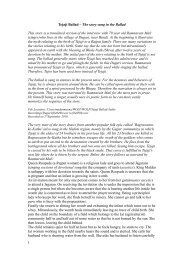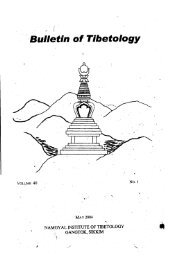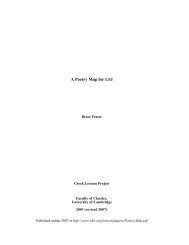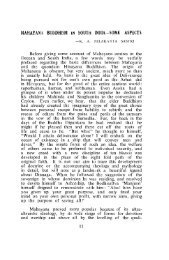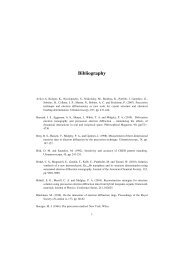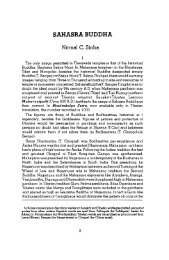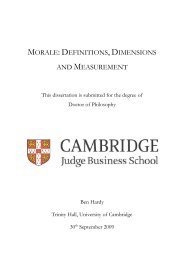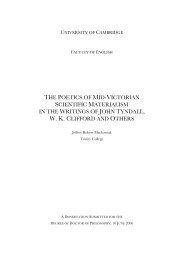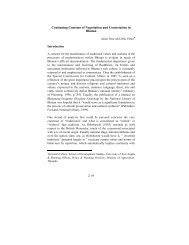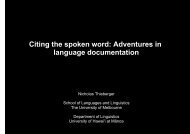The Crusades, the Genoese and the Latin East - DSpace at ...
The Crusades, the Genoese and the Latin East - DSpace at ...
The Crusades, the Genoese and the Latin East - DSpace at ...
Create successful ePaper yourself
Turn your PDF publications into a flip-book with our unique Google optimized e-Paper software.
most of <strong>the</strong> ships th<strong>at</strong> sailed in 1216 to <strong>the</strong> <strong>L<strong>at</strong>in</strong> <strong>East</strong> bore Christian names? It could be suggested<br />
th<strong>at</strong> perhaps <strong>the</strong>se ships were carrying a message of Christian devotion. Even more remarkable is<br />
<strong>the</strong> message of feminine devotion th<strong>at</strong> springs out of <strong>the</strong> list of ships' names from <strong>the</strong> year 1216.<br />
It might indeed be a coincidence th<strong>at</strong> ships were given <strong>the</strong>se feminine names; it is none<strong>the</strong>less<br />
interesting to see th<strong>at</strong> a similar process had also occurred simultaneously in <strong>Genoese</strong> society in<br />
general.<br />
'Gives michi equos abstulerunt, et ego uxores eorum crucesignavi, ' James of Vitry<br />
in Genoa 369<br />
James of Vitry's writings form part of <strong>the</strong> most interesting source for <strong>the</strong> underst<strong>and</strong>ing of <strong>the</strong><br />
Fifth Crusade. In <strong>the</strong> autumn of 1216 James arrived in Genoa <strong>and</strong> had <strong>the</strong> opportunity to spend<br />
some time <strong>the</strong>re before his embark<strong>at</strong>ion for <strong>the</strong> <strong>L<strong>at</strong>in</strong> <strong>East</strong>. In his first letter to Pope Honorius III<br />
from 04 November 1216 he explains why in his opinion Genoa is potentially <strong>the</strong> power most<br />
capable of helping <strong>the</strong> Holy L<strong>and</strong>:<br />
Sunt autem homines illi potentes et divites et strenui in armis et bellicose, habentes<br />
copiam navium et galearum optimarum, nautas habentes peritos qui Wain in mare<br />
noverunt et in terrain Sarracenorum pro mercimoniis frequenter perrexerunt, nec credo<br />
quod sit aliqua civitas, que tantumpossit iuvare ad succursum terre sancte. 370<br />
When James of Vitry first arrived in Genoa he was ra<strong>the</strong>r amazed to learn about a local<br />
custom to confisc<strong>at</strong>e all horses for <strong>the</strong> purpose of war, regardless of <strong>the</strong> owners' wishes.<br />
However, in <strong>the</strong> absence of his horses <strong>and</strong> <strong>the</strong> <strong>Genoese</strong> men, James of Vitry seized <strong>the</strong><br />
opportunity to preach to <strong>the</strong> women <strong>and</strong> <strong>the</strong> poor:<br />
Mulieres autem in civit<strong>at</strong>e remanserunt, ego vero interim feci quod potui, verbum enim<br />
Dei multis mulieribus et paucis hominibus frequenter predicavi. Multitudo autem<br />
mulierum divitum et nobilium signum crucis recepit.<br />
James <strong>the</strong>n concludes this letter in a ra<strong>the</strong>r sarcastic tone: 'cives michi equos abstulerunt,<br />
et ego uxores eorum crucesignavi. '371<br />
James of Vitry was a skilful preacher who gained a high reput<strong>at</strong>ion during <strong>the</strong><br />
Albigensian crusade. In Jon<strong>at</strong>han Riley Smith's words, '<strong>the</strong> preaching of men like... James of<br />
Vitry for <strong>the</strong> Albigensian Crusade fired popular enthusiasm. '372 In his writing, it seems th<strong>at</strong> James<br />
was aware of his impact on <strong>the</strong> crowd <strong>and</strong> th<strong>at</strong> he took pride in it. Interestingly, notarial<br />
documents which were written in Genoa <strong>at</strong> <strong>the</strong> time of his visit prove th<strong>at</strong> James' reput<strong>at</strong>ion was<br />
369<br />
Jacques de Vitry, Lettres de la Cinquieme Croisade, ed. Robert B. C. Huygens (Turnhout, 1998). Letter<br />
no. 1, from 04 November 1216, p. 30.<br />
370<br />
Ibld, p. 32.<br />
371 Ibid, p. 30. See also James Powell, An<strong>at</strong>omy of a Crusade, pp. 67-8.<br />
372 Jon<strong>at</strong>han Riley Smith, <strong>The</strong> <strong>Crusades</strong>: A Short History (London, 1986), p. 140.<br />
106



